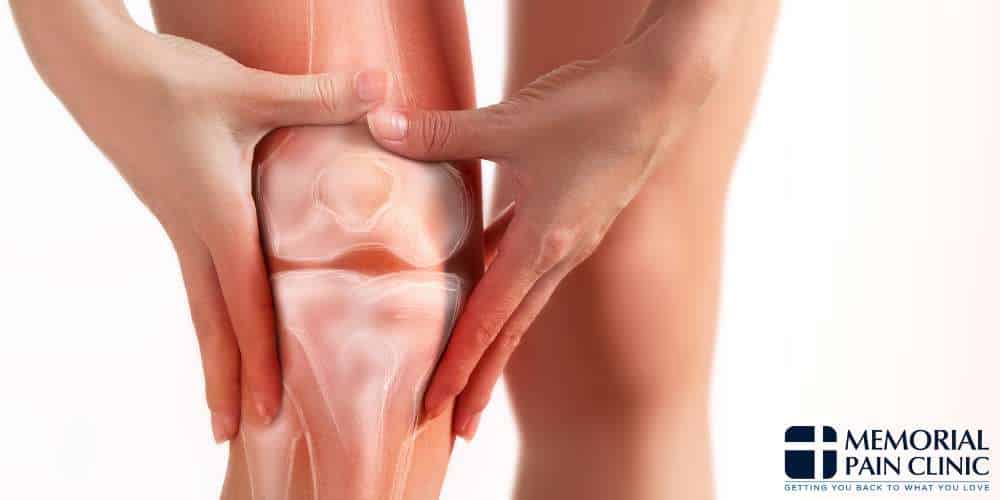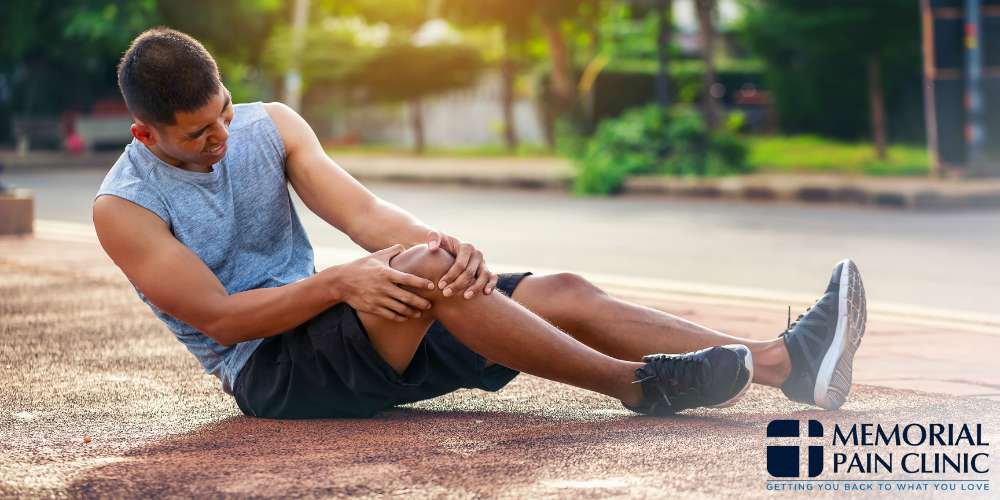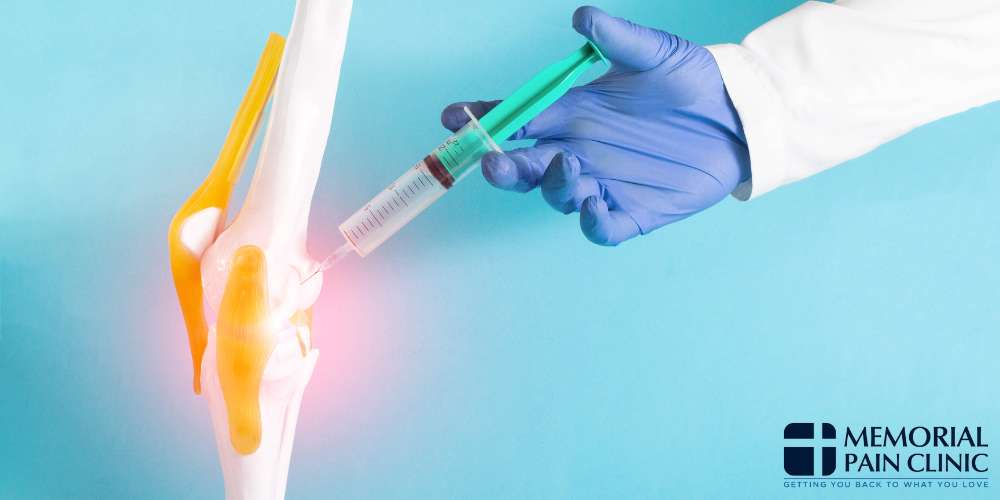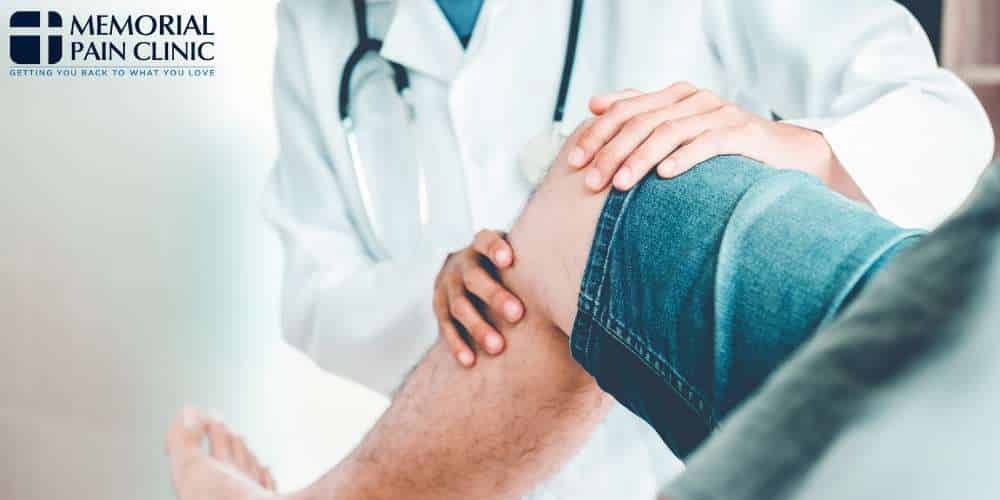Knee Pain Treatment Tulsa, OK
Our Services

Achieve Knee Pain Relief at Memorial Pain
Are you struggling with persistent knee pain and searching for effective knee pain treatment in Tulsa, OK? At Memorial Pain Clinic, we specialize in comprehensive knee pain management tailored to your unique needs. Our experienced team of pain specialists utilizes state-of-the-art techniques and personalized care plans to help you regain mobility and improve your quality of life.
Whether your knee pain is due to injury, arthritis, or another condition, we are committed to providing the relief you need right here in Tulsa. Explore our innovative treatment options and take the first step toward a pain-free life with Memorial Pain Clinic. Call (918) 200-9944 to schedule your consultation today.
Knee Joint Anatomy
The knee joint is complex and acts as a hinge connecting the thigh bone (femur) to the shin bone (tibia). It includes several moving parts and crucial structures, including the following.
Bones:
- Femur (thigh bone)
- Tibia (shin bone)
- Patella (knee cap)
Cartilage:
- Articular cartilage to cover the ends of the femur and tibia, allowing smooth movement
- Menisci that act as shock absorbers between the tibia and femur
Ligaments:
- ACL (anterior cruciate ligament) and PCL (posterior cruciate ligament) control the forward and backward movement of the knee
- MCL (medial collateral ligament) and LCL (lateral collateral ligament) provide stability to the inner and outer sides of the knee
Tendons:
- Quadriceps tendon connects the quadriceps muscle to the patella
- Patellar tendon connects the patella to the tibia
Muscles:
Several muscles around the knee, including the quadriceps and hamstrings, facilitate movement and provide support.
Bursae:
These are small fluid-filled sacs that reduce friction and cushion pressure points between the bones and tendons or muscles around the knee joint.
Types of Knee Pain

Patients experiencing knee pain have unique symptoms and perceptions of their pain. It can manifest in various areas and forms, each indicating different potential underlying causes. Some common locations for knee pain and associated conditions include the following.
Pain Behind Knee
- Baker’s Cyst: A fluid-filled cyst causing swelling and discomfort behind the knee.
- Hamstring Tendonitis: Inflammation of the tendons attaching the hamstring muscles to the knee.
- Popliteal Injury: Strain or injury to the popliteal muscle or tendon at the back of the knee.
Inner Knee Pain
- Medial Collateral Ligament (MCL) Injury: Damage to the ligament on the inner side of the knee, often due to sports-related impacts.
- Meniscus Tear: A tear in the medial meniscus, the cartilage that cushions the inner knee, often from twisting movements.
- Osteoarthritis: Degenerative joint disease that can cause pain and stiffness on the inner side of the knee.
Medial Knee Pain
This typically overlaps with inner knee pain and includes issues like MCL injuries, medial meniscus tears, and osteoarthritis affecting the medial compartment of the knee.
Lateral Knee Pain
- Lateral Collateral Ligament (LCL) Injury: Damage to the ligament on the outer side of the knee, usually from trauma or overuse.
- Iliotibial Band Syndrome (ITBS): Inflammation of the iliotibial band, a thick band of tissue running along the outside of the thigh, causing pain on the outer knee.
- Lateral Meniscus Tear: A tear in the lateral meniscus, the cartilage cushioning the outer knee.
Kneecap Pain
- Patellofemoral Pain Syndrome (Runner’s Knee): Pain around the kneecap due to misalignment or overuse, common in athletes.
- Chondromalacia Patella: Softening and breakdown of the cartilage on the underside of the kneecap.
- Patellar Tendonitis (Jumper’s Knee): Inflammation of the patellar tendon connecting the kneecap to the shinbone, often from repetitive jumping or running.
Knee Pain Symptoms
Symptoms associated with knee pain often vary depending on the underlying cause of the pain, as well as the location of the issue. Some common symptoms include the following.
- Sharp, dull, aching, or chronic pain
- Pain that worsens with activity or specific movements
- Swelling, warmth, and redness
- Stiffness and reduced range of motion
- Sensation of the knee “locking” in place
- Instability or weakness, particularly while weight-bearing
- Knee clicking or popping sensations
- Tenderness or sensitivity when pressing on the knee
- Bruising and discoloration
- Limping or favoring the unaffected leg
Common Knee Pain Causes

Knee Arthritis
Arthritis causes a reduction in cartilage (which increased the friction) between the joints. When cartilage becomes damaged or worn down, the affected joint usually becomes inflamed and restricts motion, causing arthritis pain. Osteoarthritis gradually develops as we age, whereas Rheumatoid Arthritis often has system-wide symptoms and a genetic relationship.
If you’re struggling with arthritis, contact Memorial Pain to learn about our various arthritis treatments in Tulsa.
Osteoarthritis in Knee
One of the most prevalent causes of knee pain is osteoarthritis, a degenerative joint disease characterized by the gradual breakdown of cartilage that cushions the ends of bones in the knee joint. This condition typically affects older adults and results in symptoms such as pain, stiffness, swelling, and reduced range of motion. As the cartilage wears away, bones may rub against each other, leading to increased pain and the formation of bone spurs. Osteoarthritis can significantly impair daily activities and reduce quality of life.
Knee Bursitis
Bursae are fluid-filled cavities that reduce friction and assist in joint movement. Chronic overuse, trauma, infection, or arthritis may cause inflammation, joint pain, stiffness, and swelling. Symptoms usually improve with conservative treatment.
Knee Injuries and Overuse
Another major category of knee pain causes is knee injuries, which can occur due to sports, accidents, or sudden movements. Injuries like ACL tears, MCL tears, meniscus tears, and patellar tendinitis can cause acute pain, swelling, instability, and difficulty moving the knee.
Overuse is another common cause of knee pain, particularly among athletes and individuals with physically demanding jobs. Conditions like runner’s knee, IT band syndrome, and bursitis can cause gradual onset of pain and can limit participation in physical activities.
Complex Regional Pain Syndrome (CRPS)
CRPS is a chronic progressive disease that commonly affects the extremities by causing severe pain, swelling, and noticeable changes in the skin. The cause of CRPS is unknown, but is thought to be a result from damage to the nervous or circulatory system. Blood flow and sensation are no longer properly regulated and may cause various problems in the muscles, bones, nerves, and skin.
Knee Pain Diagnosis
Diagnosing knee pain involves a combination of medical history, physical examination, and diagnostic tests. Initially, we will take a detailed medical history to understand the onset, duration, and nature of the pain, as well as any associated symptoms or previous injuries. The patient’s activity level, occupation, and any factors that exacerbate or alleviate the pain will also be discussed. This information helps narrow down potential causes and guides further examination.
During the physical examination, we will inspect the affected knee for signs of swelling, bruising, or deformity. We will palpate the knee to identify areas of tenderness and assess the range of motion by having you bend and straighten the knee. We will also test the knee’s stability by moving it in different directions to check for ligament integrity and examine the strength and flexibility of the surrounding muscles.
If further evaluation is needed, we may order imaging tests such as X-rays, MRI, or CT scans. X-rays are useful for identifying bone fractures, joint alignment issues, and signs of osteoarthritis. MRI scans provide detailed images of soft tissues, including ligaments, tendons, cartilage, and menisci, which can help diagnose tears or other injuries. In some cases, ultrasound may be used to visualize soft tissues and guide needle placement for aspiration or injections. Blood tests might be performed if an infection or inflammatory condition like rheumatoid arthritis is suspected.
Knee Pain Treatments in Tulsa, OK

To achieve knee joint pain relief, we typically begin with conservative knee pain treatment options. For many patients, non-surgical treatments can effectively alleviate pain and improve function. Non-surgical options allow patients to achieve pain relief without the need for invasive surgery.
Non-Surgical Knee Pain Treatments
Conservative treatments are generally the first line of defense when it comes to alleviating knee pain. Many patients want to avoid knee surgery if possible, so we often start with medications, injections, and sometimes recommend physical therapy.
Medications
Medications are often the first method of treatment. They typically provide temporary pain relief. Over-the-counter pain relievers like acetaminophen and nonsteroidal anti-inflammatory drugs (NSAIDs) such as ibuprofen and naproxen can reduce pain and inflammation. In cases of more severe pain or inflammation, prescription medications, including stronger NSAIDs, corticosteroids, or topical analgesics, may be recommended.
What Is the Best Painkiller for Knee Pain?
The best painkiller for knee pain depends on factors such as the cause and severity of the pain, as well as individual health considerations. Over-the-counter options like acetaminophen or NSAIDs (ibuprofen, naproxen) are often effective to ease knee pain that is mild to moderate.
Physical Therapy
Physical therapy is another cornerstone of non-surgical treatment for knee pain. A physical therapist can design a personalized exercise program to strengthen the muscles around the knee, improve flexibility, and enhance joint stability. Exercises often focus on strengthening the quadriceps, hamstrings, and calf muscles, which support and stabilize the knee joint.
Additionally, physical therapy may include techniques like manual therapy, ultrasound, or electrical stimulation to reduce pain and promote healing. Patients are also taught proper techniques for daily activities to prevent further injury. Some physical therapists may recommend wearing a knee brace for added support.
Injections
Injections offer another non-surgical option for managing knee pain, particularly for conditions like osteoarthritis or inflammatory arthritis. Corticosteroid injections can provide quick and effective relief from inflammation and pain, although the effects are usually temporary. Hyaluronic acid injections, also known as viscosupplementation, aim to improve joint lubrication and reduce pain in arthritic knees.
Platelet-rich plasma (PRP) injections, which use the patient’s own blood components to promote healing, are becoming increasingly popular for treating various knee injuries and degenerative conditions. At Memorial Pain, we provide PRP injections in Tulsa as a form of regenerative knee pain therapy.
Call Memorial Pain in Tulsa to Relieve Pain in Your Knee

If you’re in Tulsa, OK, and seeking relief from knee pain, look no further than Memorial Pain Clinic. Our dedicated team of specialists is committed to providing comprehensive and personalized care to help you overcome or prevent knee pain and regain your quality of life. From conservative treatments like medications and physical therapy to advanced interventions such as injections and minimally invasive procedures, we offer a range of options tailored to your specific needs.
Don’t let knee pain hold you back any longer. Schedule a consultation with Memorial Pain Clinic today and take the first step toward a pain-free future.

